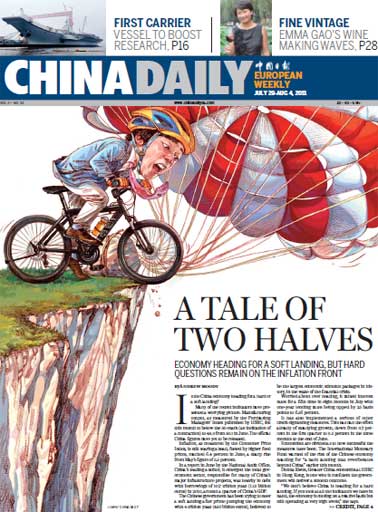Op-Ed Contributors
US deficit debacle has begun
Updated: 2011-08-02 07:53
By Dan Steinbock (China Daily)
Since mid-May, the United States has lived on borrowed time as Washington has debated multiple deficit-plans before the Aug 2 deadline.
After last-minute twists and turns, a deal seemed to come together on Sunday evening, when lawmakers closed a $3-trillion deal, in order to raise the US borrowing limit by $1 trillion and to assure financial markets that Washington will avoid a default.
Despite all the hype and drama, the proposed plan is a fragile and minimal two-stage deal that will not satisfy most Republicans or Democrats. If successful, it will avoid a US default. But it is unlikely to avert the downgrading of US credit rating, which, in turn, would have an adverse impact on US recovery.
In November 2010, US President Barack Obama's bipartisan National Commission on Fiscal Responsibility and Reform produced a $4-trillion plan. This "Bowles-Simpson" plan called for $2 in budget cuts for every $1 in revenue increase. The plan failed in a vote.
Then came the bipartisan $3.7-trillion "Gang of Six" plan, which was closely patterned on the recommendations of the bipartisan commission: $2.50 in budget cuts for every $1.20 in tax revenue increase. By mid-July, a scaled-down $1.5-trillion plan by the Senate's leaders, the Republican Mitch McConnell, and the Democratic Harry Reid, proposed $1.50 trillion in spending cuts, but no tax increase.
Neither was enough for the Tea Party, whose members were pushing a large $5.5-trillion "Cut, Cap and Balance" bill without any tax increase.
The resulting stalemate virtually ensured that no compromise would be possible until the last moment - that any compromise would be strong enough to achieve a new debt ceiling but too weak to prevent the downgrading of US credit rating.
If there is a single common denominator to this long-winding debate, it is the steady shift away from the pressing issues of US stagnation and unemployment to the issues of deficit cuts and austerity.
This shift will deepen the already deep economic polarization in America. It does not reflect the views of ordinary Americans. Only 7 percent of Americans believe that budget deficit/national debt is the most important problem facing America today, according to a recent CBS News/The New York Times poll. In contrast, some 53 percent of Americans believe that economy and jobs are the nation's priority today.
Concurrently, the revised GDP figures indicate that the US economy is barely breathing, growing only 1.3 percent in the second quarter (and the next quarter looks gloomy). Unsurprisingly, a whopping 79 percent of Americans are dissatisfied with the direction of the nation, according to Pew Research.
In the foreseeable future, deepening economic and political polarization will make things worse.
The Washington stalemate has been remarkable, considering that foreign nations fund almost half of the US budget deficit by holding Treasury Securities. While unlikely and currently improbable, a sudden rush for the exits cannot be ruled out completely.
So what if, for whatever reason, foreign holders would disinvest their treasuries?
There are three basic withdrawal scenarios. In the sudden withdrawal scenario, the price of US Treasuries would plunge in US securities markets. Conversely, the market rate of interest would climb. The dollar would fall in value relative to other currencies. In turn, the subsequent uncertainty associated with the US marketplace would dramatically reduce the postwar trust in Pax Americana.
In the diversification scenario, foreign investors would seek to diversify the composition of their portfolios by replacing a significant share of their holdings of US Treasuries with other dollar-denominated assets. The price of the Treasuries would decline and the prices of other assets would rise. Investors would run away toward other dollar-denominated assets.
In the shift away from dollar-denominated assets scenario, foreign investors would try to pare down their holdings of dollar-denominated assets through a liquidation of part or all of their holdings of dollar-denominated assets, possibly even direct investments (in US businesses and real estate), either slowly or rapidly.
In May, the grand total of foreign holders amounted to more than $4.5 trillion. China accounted for more than 26 percent, followed by Japan (20 percent), the United Kingdom (8 percent), oil exporters (5 percent), Brazil (5 percent) and Russia (3 percent). While international speculation over withdrawal scenarios tends to focus on the role of China, non-Chinese interests account for 74 percent of the foreign holders' total.
Moreover, advanced economies - Japan, the UK, Ireland, Italy, and France - which account for a major portion of the US Treasuries have substantial debt problems of their own.
In Japan, gross debt exceeds 210 percent of GDP. In the UK, growth is stagnating and economic problems keep mounting. Ireland has already been bailed out once. With a 1.6 trillion debt, Italy is dependent on investors' confidence to keep its interest payments low. Even France's economic prospects are clouded by a challenging external environment, especially by possible spillovers from the euro area crisis.
Today, the de facto US national debt is approaching $14.6 trillion. In order to sustain its triple-A rating, Washington should have opted for a credible long-term fiscal adjustment (read: a $4-trillion, one-stage deal).
In the absence of a credible, long-term fiscal adjustment and adequate containment of health care costs, the postwar trust in the US economic prospects has now been shaken.
In the foreseeable future, it is prudent for the leading emerging powers to continue gradual diversification and an incremental move toward alternative assets along with US treasuries. Risks will be more diversified in a multipolar world economy.
The author is research director of International Business at the India, China and America Institute, an independent think tank in the US, and visiting fellow at Shanghai Institutes for International Studies.
(China Daily 08/02/2011 page9)
E-paper

Double vision
Prosperous Hangzhou banks on creative energies to bridge traditional and modern sectors
Minding matters
A touch of glass
No longer going by the book
Specials

Carrier set for maiden voyage
China is refitting an obsolete aircraft carrier bought from Ukraine for research and training purposes.

Pulling heart strings
The 5,000-year-old guqin holds a special place for both european and Chinese music lovers

Fit to a tea
Sixth-generation member of tea family brews up new ideas to modernize a time-honored business
